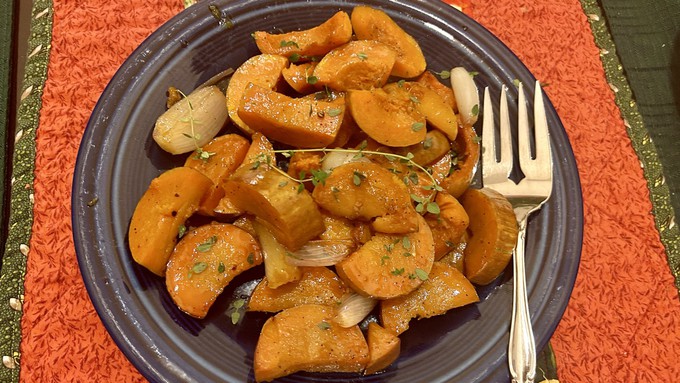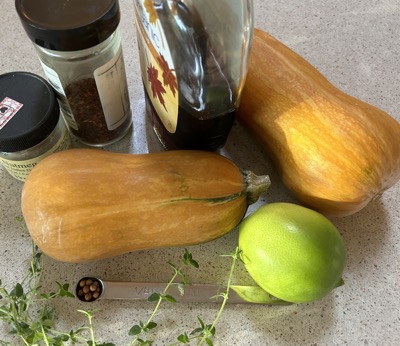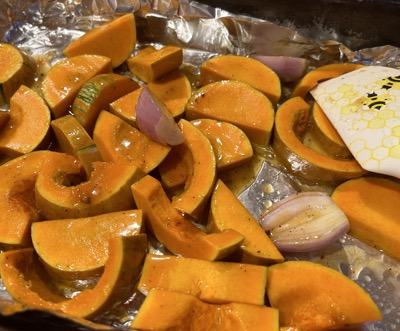
Recipe: Maple glaze is subtly spiced; lime juice adds balance

Sprinkled with lime juice and fresh thyme just before serving, the Honey Nut squash makes a delicious seasonal side dish. Kathy Morrison
It's squash season -- decorative and otherwise -- which means we vegetable gardeners get to explore all the things that squash can do. Well, beyond pie, which is a given.
This is the first year I've successfully grown Honey Nut squash. This little squash, which looks like butternut's younger, oranger sibling, is a relatively new member of the squash family. It was developed by a Cornell University Institute plant breeder, Michael Mazourek, who in 2009 was challenged by a New York chef to create a squash that was smaller, sweeter and less stringy than the ubiquitous butternut. I'd say he succeeded.

As a bonus, Honey Nut is much easier to cut in half than just about any other orange squash, and the skin is thin enough to eat when cooked, so no peeling needed.
Back in May I planted two hills of seeds at the base of a strong trellis, and they've been very happy, sprawling but taking up much less room than, say, a pumpkin plant. The largest one I've harvested so far is about 1-1/2 pounds, the smallest just half a pound. Like other squash, they need to cure for about 10 days before cooking or storing.
"You grew it, now eat it!" says Farmer Fred Hoffman. OK, let's show off this cute squash in a side dish that doesn't overwhelm with sweetness. This version was freely adapted from a NY Times recipe. The spices can be adjusted for personal taste, but if at all possible don't leave out the lime juice -- it balances the spicy-sweet perfectly. (And my limes are ripening, too -- nice timing.)
Looking ahead: Doubled, this recipe would make a fine addition to a Thanksgiving spread.
Roasted winter squash with spiced maple glaze
Serves 3-4
Ingredients:

1 to 1-1/2 pounds small winter squash(es), such as Honey Nut, Sweet Dumpling or Delicata
2 shallots, peeled and cut in half or quartered, depending on size
3 tablespoons real maple syrup
Large pinch Aleppo pepper or crushed red pepper flakes, or to taste
2 tablespoons unsalted butter
1/8 teaspoon coriander seeds or ground coriander
1/2 teaspoon kosher salt
1/4 teaspoon ground black pepper
Pinch of ground nutmeg
Pinch of smoked paprika
For serving:
Several sprigs of fresh thyme
Lime juice from 1/2 fresh lime
Instructions:
Line a roasting pan with heavy-duty foil (preferred), or sturdy parchment paper, and grease the inside lightly with oil spray or heat-tolerant cooking oil (grapeseed oil is my go-to for this). Preheat oven to 425 degrees F.
Cut the stem and blossom ends off the squash, and slice the squash in half. Scoop out the seeds. (A melon baller is useful for this.) Slice each half crosswise into 1/2-inch slices. Place the slices in a large bowl, along with the shallot pieces, and set aside.

In a small saucepan, simmer the maple syrup and Aleppo pepper on medium-high heat for 1 to 3 minutes. Don't walk away from the stove -- this can overcook or scorch easily. You just want to concentrate and flavor the syrup a bit.
Remove the pan from the heat and stir in the butter, which will melt, and the coriander, salt and pepper, nutmeg and smoked paprika.
Pour the mixture over the squash slices and shallot pieces, and stir to coat evenly.
Place the squash mixture, including all the liquid, in the prepared pan in one layer.
Roast for 15 minutes. Stir the vegetables, flipping them over, and cook for an additional 10 minutes or until skin on the squash is tender.
Remove from heat and place the vegetables on a serving platter or bowl. Squeeze the lime half over the vegetables, then strip the thyme off the stems and sprinkle it over the plate, and serve.
Comments
0 comments have been posted.Sacramento Digs Gardening to your inbox.
Sites We Like
Garden Checklist for week of July 21
Your garden needs you!
* Keep your vegetable garden watered, mulched and weeded. Water before 8 a.m. to reduce the chance of fungal infection and to conserve moisture.
* Feed vegetable plants bone meal, rock phosphate or other fertilizers high in phosphate to stimulate more blooms and fruiting. (But wait until daily high temperatures drop out of the 100s.)
* Don’t let tomatoes wilt or dry out completely. Give tomatoes a deep watering two to three times a week.
* Harvest vegetables promptly to encourage plants to produce more. Squash especially tends to grow rapidly in hot weather. Keep an eye on zucchini.
* Pinch back chrysanthemums for bushy plants and more flowers in September.
* Remove spent flowers from roses, daylilies and other bloomers as they finish flowering.
* Pinch off blooms from basil so the plant will grow more leaves.
* Cut back lavender after flowering to promote a second bloom.
* It's not too late to add a splash of color. Plant petunias, snapdragons, zinnias and marigolds.
* From seed, plant corn, pumpkins, radishes, winter squash and sunflowers.